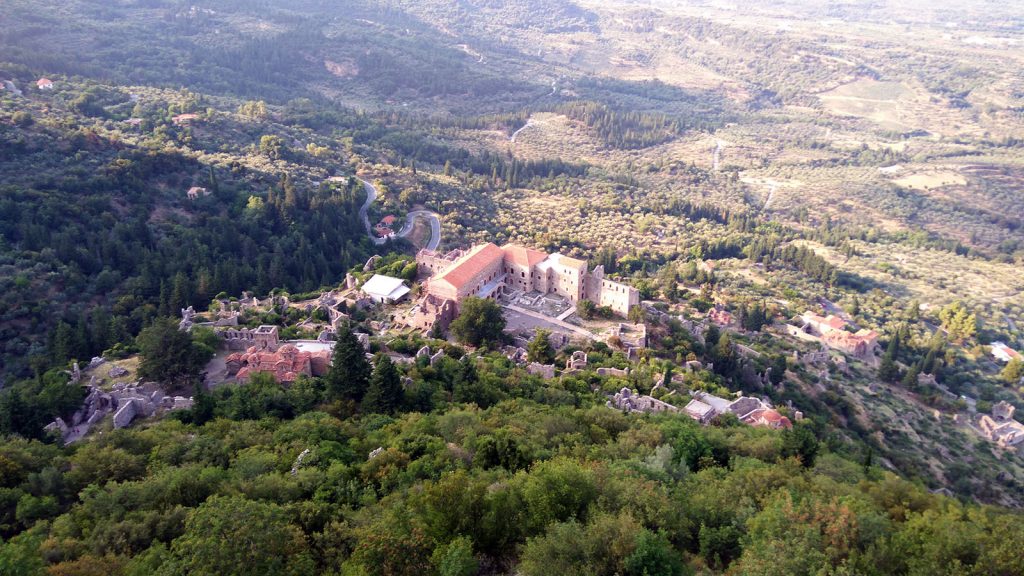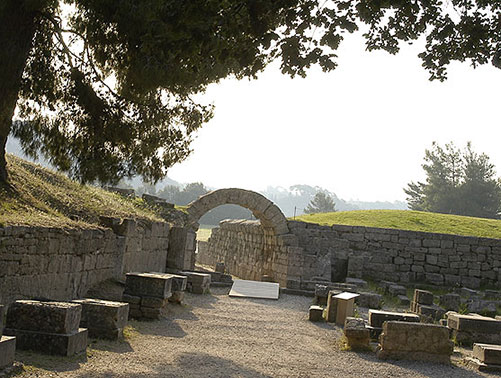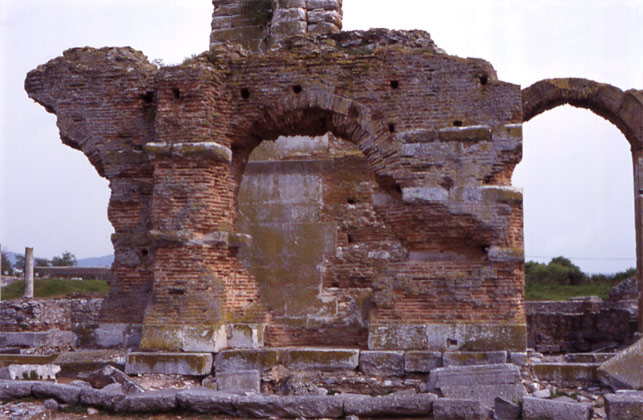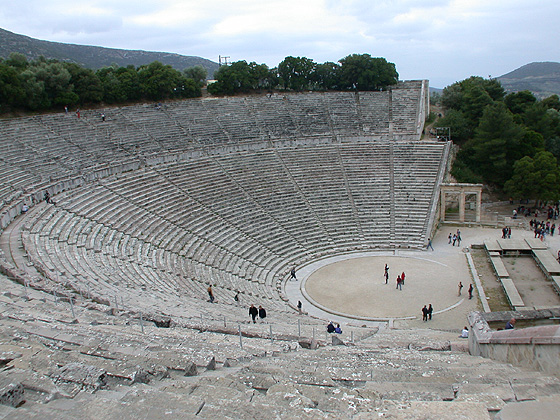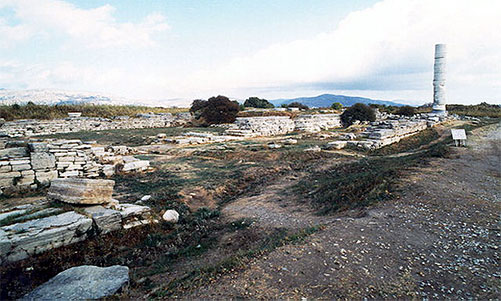The Heraion of Samos is located at the southwestern end of the valley formed by alluvial remains of the river Imvrasos, in the south of the island. At the northeastern end of the same valley, at a distance of six kilometers from the Heraion, the ancient city of Samos (Pythagorion) was located, in whose jurisdiction the sanctuary belonged, as was the entire island. A major road, the sacred road, connected the city with the Heraion in ancient times, which played a central role in the ritual processions that took place during religious festivals. The street was framed by luxurious votive offerings of the faithful which today are considered unique findings of ancient Greek art.
The site where the Heraion was founded was dictated by local tradition, according to which Hera was born on this site (under a chaste tree, the sanctuary’s sacred tree) and it was there that she married Zeus. The location, however, was completely unsuitable for the construction projects carried out there. The alluvial deposits that make up the plain’s soil were precarious for the foundations of such large buildings as those built in the Heraion of Samos from the 8th to the 6th century BC. Thus, the first Ekatompedos temple ( Εκατόμπεδος = 100 feet, approx. 33 meters) built on the site in the 8th century BC, was replaced at the end of the 7th century by another temple. A few decades later, at the beginning of the 6th century, a much larger temple was built, about 100 meters long and 50 meters wide (the so-called temple of Roikos). But the life of the temple was short, as around 550 BC, the building collapsed, most likely due to unstable ground. At that time an even bigger temple was built, measuring about 108 x 52 meters, the largest temple that the ancient Greeks had built until then, according to the descriptions of Herodotus. This temple was built about 40 meters west of the previous one, apparently on more solid ground. The temple is attributed to the tyrant of Samos Polycrates and in fact was never completed, since after the death of the tyrant in 522 BC, Samos was not as financially prosperous as before to allow for the completion of such a grand project.
Indeed, in contrast to other places in the ancient Greek world which prospered in the Classical period (5th-4th century), Samos’ heyday came earlier, from the 8th to the 6th century BC. During this period, Samos had developed trade contacts with the Black Sea, Asia Minor, mainland Greece, Egypt and the Middle East, and during Polycrates’ rule it was undoubtedly the largest naval power in the Aegean. The tyrant had close contacts with the pharaoh of Egypt Amasis, was responsible for the construction of a magnificent technological project for the time, the so-called Eupalinos Tunnel (i.e., an underground aqueduct longer than 1 km which brought water to the city of Samos), and his court hosted leading artists of the time, such as the lyric poet Anacreon. A typical example of the power that the island possessed in the 6th century throughout the Aegean is the fact that the tyrant was able to donate to the sanctuary of Apollo in Delos the neighboring island of Rhenia. The accumulated wealth and political power operated in defiance of natural phenomena and ecological factors: while the precarious subsoil dictated the relocation of the sanctuary to another site, or at least the construction of smaller buildings, the Samians, on the other hand, were in a position to return after each failure with more and more grandiose plans.
After the death of Polycrates, however, things gradually changed. Samos retreated before the forces of Persia and then of Athens. In 439 BC, the city was conquered by the Athenians and in 365 its inhabitants were exiled and replaced by Athenian clerurchs. The decline of Samos in the Classical and Hellenistic period is also reflected in the Heraion, where construction activity was negligible.
Indeed, after the peak of the island’s prosperity during the Archaic period, the next phase of prosperity of Samos occurred in the Roman period. The main difference between the two phases, however, is that on the one hand the economic power of Samos in the Roman period did not reach that of the Archaic period, and on the other, it was not accompanied by corresponding political power; the island had been a Roman ally since the second century BC and developed close relationships with important personages of the period: Brutus, Marc Antony and Cleopatra, Octavian Augustus, Tiberius, Caligula, and Agrippa were some of those who visited Samos. Octavian, in particular, traveled to the island more than once and in remembrance of his last visit declared Samos a civitas libera and tax-free city. In return, the Samians built a temple dedicated to Augustus and Rome and dedicated many votive offerings to him. Several new buildings and facilities were built in the city, among them an aqueduct, which replaced, after many centuries of operation, the Eupalinus Tunnel.
In the Heraion, the ancient temple of Polycrates remained unfinished without a roof and simply housed valuable votive offerings. Its completion required a sum of money that obviously exceeded the financial capabilities of the city and / or the disposition of a potential sponsor. Instead, in the Roman period, the Heraion was replaced by another structure, in marble but much smaller, built to its east. In addition, the Archaic altar was rebuilt, whose material (local soft limestone) was by then worn out. The new altar was also made of marble but copied the Archaic decorative motifs. In addition to the temple of Hera and its altar, two more temples and baths were built in the sanctuary, while the sacred road was paved along its entire length, an extremely expensive project which was financed by the wife of the emperor Septimius Severus, Julia Domna. It is possible that the work was not carried out for the needs of the operation of the Heraion but in order to serve the needs of the luxurious suburb that was installed inside the sanctuary at this time.
The early Christian basilica, built on the site in the 5th century AD, marked the end of paganism and the last building phase in the sanctuary. Since then, the site was abandoned and became a source of building materials. The first excavations began in the first decade of the 20th century by the Archaeological Society at Athens, which continued from 1925 onwards by the German Archaeological Institute. The main problem of the excavations, but also of the preservation of the monuments that came to light, was (and is) the swampy area in which the Heraion is located. In the past, access to the area ranged from very difficult to impossible during the winter months due to the stagnant water. In addition, the marsh of the area drowns the antiquities in the reeds and in the pads, creating significant erosion and becoming fire hazards during the summer months. An important corrosive factor for the soft local limestone with which most of the monuments were built is posed by the combination of high humidity at the bottom of the ruins and high temperatures from the sun in the upper parts.
Sources
Shipley, A history of Samos 800-188 BC, Oxford 1987,
Τ. Dimitriou, Το ρωμαϊκό υδραγωγείο της Σάμου, Samos 2003,
Κ. Τsakos, Σάμος. Ιστορικός και αρχαιολογικός οδηγός, Αthens 2003,
Κ. Τsakos and Μ. Viglaki-Sophianou, Σάμος: Τα αρχαιολογικά μουσεία, Αthens 2012.




